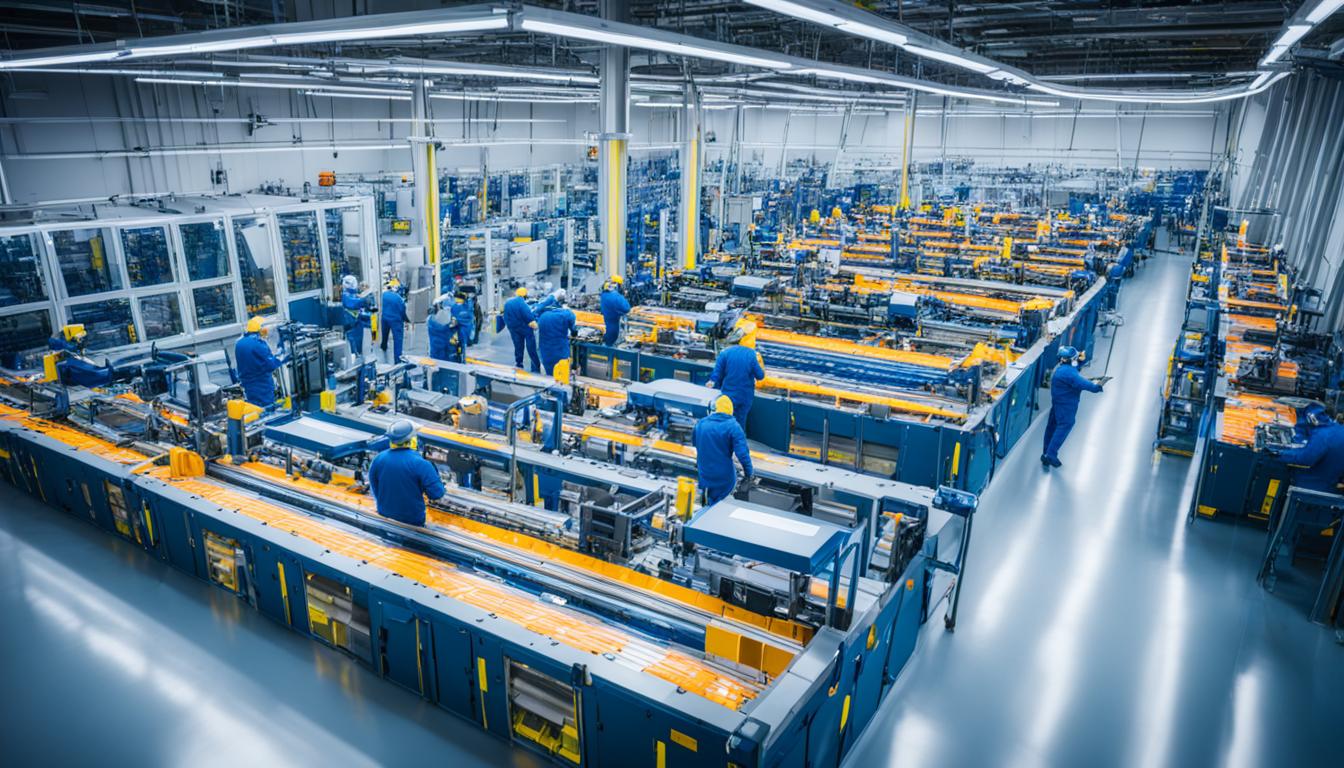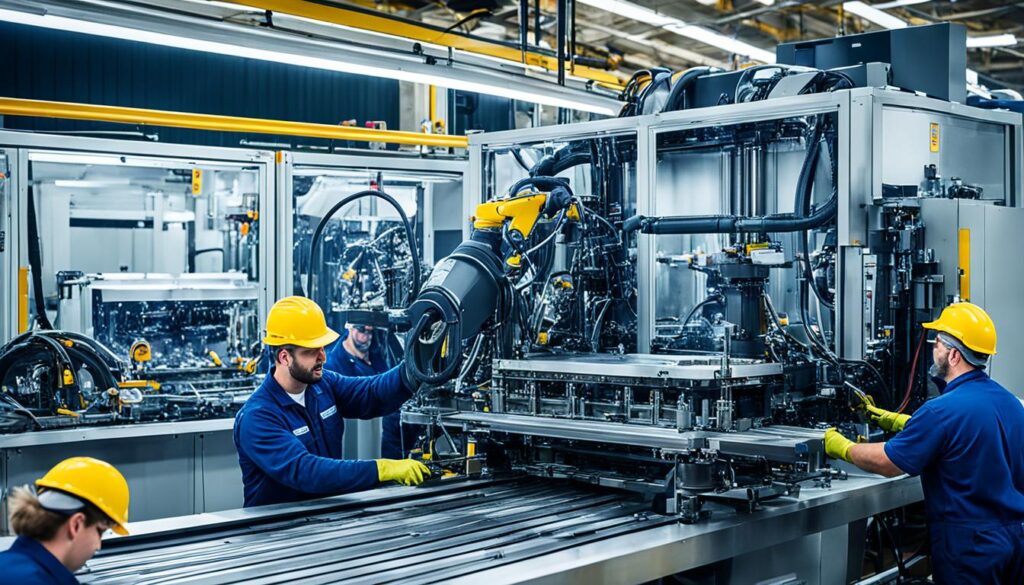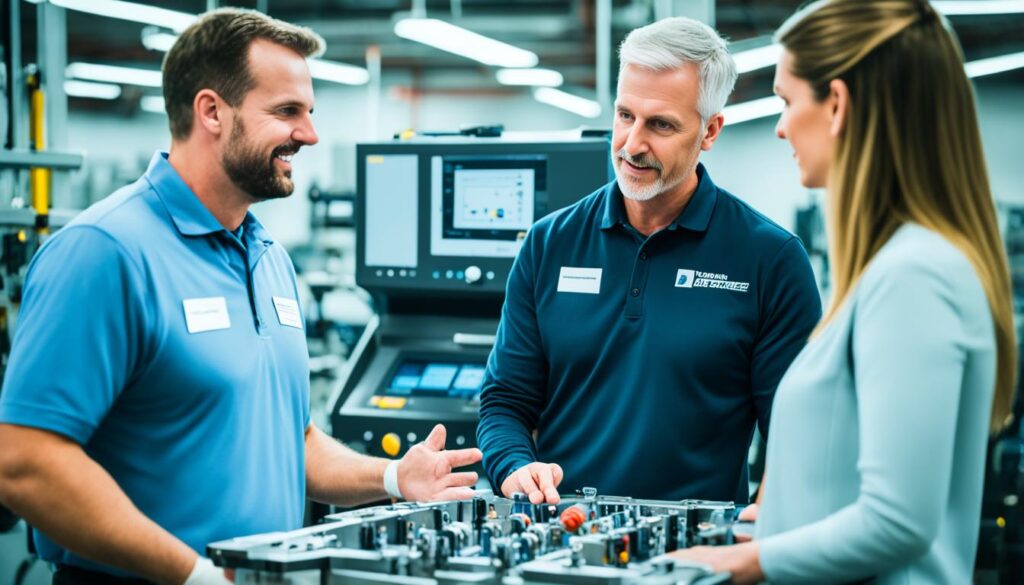Boost Your Manufacturing Productivity Today!

Are you looking to improve manufacturing efficiency and boost factory performance? If so, it’s time to take a closer look at your manufacturing productivity. Increasing productivity is not only crucial for driving profits and staying ahead of competitors, but it also plays a vital role in production optimization and streamlining manufacturing operations.
In this article, we will explore six key strategies to help you increase productivity in your manufacturing facility. From reviewing your existing workflow to updating processes and technology, committing to scheduled maintenance, training and educating employees, and organizing the workspace, these methods will empower you to optimize operational output and maximize industrial productivity.
Key Takeaways:
- Improving manufacturing productivity is crucial for driving profits and outperforming competitors
- Review your existing workflow to identify areas for improvement
- Update processes and technology to increase efficiency and reduce errors
- Commit to scheduled maintenance to minimize unexpected downtime
- Train and educate employees to enhance their skills and performance
Review Your Existing Workflow
When it comes to increasing manufacturing productivity, the first step is to review your existing workflow. This comprehensive review will help you identify any needed changes in people, processes, equipment, and technology. By assessing these key areas, you can pinpoint inefficiencies, bottlenecks, and areas of improvement, ultimately enhancing your overall productivity.
Start by evaluating the people in your manufacturing facility. Are the right skills in the right places? Do your employees have the necessary training and expertise to perform their tasks efficiently? Consider conducting training programs or reassigning roles to optimize the workforce.
Next, analyze your processes. Are they streamlined and well-defined, or do they involve unnecessary steps and delays? Look for opportunities to eliminate redundant tasks, simplify workflows, and standardize procedures. Streamlining processes can significantly improve productivity and reduce errors.
Assessing your equipment and technology is just as important. Are you using outdated machinery? Is your technology up to date? Evaluate whether your current equipment and technology are meeting your production needs effectively. Consider investing in new machinery or software solutions that can automate tasks and improve efficiency.
Evaluating Your Existing Workflow
Reviewing your existing workflow involves:
- Assessing the skills of your workforce
- Evaluating the efficiency of your processes
- Examining the effectiveness of your equipment and technology
By identifying areas that require improvement, you can develop a plan to optimize your workflow and boost productivity.

| Key Areas to Review | Questions to Consider |
|---|---|
| People |
|
| Processes |
|
| Equipment and Technology |
|
Update Processes and Technology
Now that you have reviewed your existing workflow, it’s time to update your processes and technology. This crucial step will help you stay competitive in today’s rapidly evolving manufacturing landscape. By leveraging automation, software solutions, and equipment improvements, you can significantly enhance your productivity and efficiency.
Implement Automation for Increased Efficiency
Automation streamlines repetitive tasks, eliminates manual errors, and accelerates production processes. By automating various aspects of your workflow, such as inventory management or quality control, you can save valuable time and resources while ensuring consistency and accuracy. Embracing automation not only improves efficiency but also frees up your workforce to focus on more complex and value-added tasks.
Utilize Software Solutions for Smarter Operations
Software solutions offer a range of benefits for optimizing manufacturing operations. Look for comprehensive solutions that can aid in scheduling, inventory management, and workflow monitoring. These tools provide real-time insights, enabling you to make informed decisions, identify bottlenecks, and allocate resources effectively. By harnessing the power of software, you can streamline your processes, improve coordination, and boost overall productivity.
Upgrade Equipment and Technology for Enhanced Performance
Assess your current equipment and technology to identify areas that need improvement. Consider investing in advanced machinery that offers higher production speed and superior quality output. Upgrading your technology infrastructure ensures compatibility with modern systems, reduces downtime due to equipment failures, and enhances overall productivity. When making these updates, calculate the total cost of ownership and evaluate the potential long-term impact on your bottom line.
By keeping your processes up to date and embracing the latest technological advancements, you position your manufacturing facility for success. Automation, software solutions, and equipment improvements are essential ingredients for achieving higher productivity and maximizing efficiency.

Commit to Scheduled Maintenance
In order to optimize productivity in your manufacturing facility, it is crucial to prioritize scheduled maintenance. Regularly maintaining and repairing equipment is essential for minimizing unexpected downtime and work stoppages. By committing to scheduled maintenance, you can keep your equipment running smoothly and prevent costly delays in production.
One key aspect of scheduled maintenance is implementing preventive maintenance procedures. This involves conducting routine inspections, replacing worn-out parts, and addressing potential issues before they escalate. By proactively addressing maintenance needs, you can prevent equipment breakdowns and ensure continuous operation.
Benefits of Scheduled Maintenance
- Minimizes unexpected downtime: By identifying and addressing equipment issues early on, scheduled maintenance helps to reduce unexpected downtime. This ensures that your manufacturing processes run smoothly and efficiently.
- Reduces repair costs: Regularly maintaining your equipment can help to identify and address minor issues before they turn into major problems. This can save you from costly repairs and replacement of equipment.
- Enhances equipment lifespan: Proper maintenance can extend the lifespan of your equipment, allowing you to get maximum value from your investments.
- Improves safety: Well-maintained equipment is less likely to malfunction, reducing the risk of accidents and injuries in the workplace.
Creating a culture of scheduled maintenance involves training all operators in regular maintenance and troubleshooting procedures. This ensures that everyone in your facility is capable of addressing maintenance needs as they arise. Additionally, it is important to schedule preventive maintenance at regular intervals to ensure that all necessary inspections and repairs are conducted in a timely manner.

By committing to scheduled maintenance, you can minimize equipment downtime, optimize productivity, and ensure the smooth operation of your manufacturing processes. Make scheduled maintenance a priority in your facility and reap the benefits of improved efficiency and reduced downtime.
Train and Educate Employees
Employee training and education are essential factors in improving productivity within your manufacturing facility. By investing in the development of your employees’ skills and knowledge, you can create a more efficient and effective workforce. This section will explore the key strategies for training and educating your employees to optimize their performance.
Regular Training Sessions for Operators
It is crucial to schedule regular training sessions for all operators, especially when new equipment is installed or new processes are introduced. These training sessions will ensure that your employees are well-equipped to handle the tasks assigned to them and to operate machinery effectively. By providing ongoing training, you can keep your workforce up-to-date with the latest industry trends and best practices, ultimately contributing to improved productivity.
Accurate Records and Refresher Programs
Keeping accurate records of training sessions and certifications is necessary to ensure that all employees have received the necessary training. Additionally, offering refresher programs can help employees maintain and enhance their skills over time. These refresher programs can be particularly valuable in situations where employees may not frequently use certain skills or operate specific machinery.
Providing Opportunities for Skills Development
Encouraging ongoing education and skills development is crucial for nurturing a highly skilled workforce. Provide your employees with opportunities to attend workshops, seminars, or online courses that align with their job responsibilities and interests. By investing in their professional growth, you empower them to contribute more effectively to the manufacturing processes and productivity within your facility.
Emphasizing Workplace Policies
Beyond technical training, it is essential to ensure that all employees understand and adhere to workplace policies. Training sessions should incorporate discussions on harassment prevention, effective communication, and any other policies specific to your manufacturing facility. By promoting a positive and respectful work environment, you can cultivate strong teamwork and collaboration among your employees, further supporting productivity.

Well-trained and educated employees are a valuable asset to any manufacturing facility. Continuously investing in their development not only improves their skills but also fosters a sense of loyalty and commitment to your organization. With a skilled and knowledgeable workforce, you can create a smoother-running manufacturing facility that maximizes productivity and achieves optimal operational performance.
Organize the Workspace
An organized workspace is essential for maximizing productivity in your manufacturing facility. By optimizing task efficiency and establishing the optimal layout of tools and materials, you can reduce excess movement and streamline your operations. Here are some key steps to organizing your workspace:
1. Optimize Task Efficiency
Review your manufacturing processes and identify areas where tasks can be streamlined. Analyze the sequence of operations and eliminate any unnecessary steps that contribute to wasted time and effort. By improving task efficiency, you can minimize production delays and enhance overall productivity.
2. Establish the Optimal Layout
Carefully consider the placement of tools, equipment, and materials in your workspace. Arrange them in a logical and ergonomic manner to minimize the need for excessive movement. Keep frequently used items within easy reach to improve workflow efficiency. Additionally, create designated storage areas for tools and materials to promote organization and reduce clutter.
3. Remove Unused Tools and Materials
Regularly assess your workspace and remove any tools or materials that are no longer needed. Clutter can hinder productivity and create unnecessary distractions. By keeping your workspace clean and free from unnecessary items, you can create a more focused and efficient working environment.
4. Layout the Manufacturing Floor
Consider the layout of your manufacturing floor to reduce travel time and distance between workstations. Arrange workstations in a way that minimizes the need for excessive movement, allowing your employees to complete tasks more efficiently. This can significantly contribute to reducing production time and improving overall productivity.
5. Implement Kanban Techniques
Consider implementing Kanban techniques to optimize workflow and minimize delays. Kanban is a system that uses visual cues, such as cards or digital boards, to track the progress of tasks and materials. By utilizing Kanban, you can enhance communication, improve task prioritization, and ensure a smooth flow of work throughout your manufacturing process.
By organizing your workspace and implementing these strategies, you can reduce excess movement, improve task efficiency, and create a more productive manufacturing environment. An organized and well-optimized workspace lays the foundation for increased productivity and paves the way for operational success.
| Benefits of Workspace Organization | Actions to Take |
|---|---|
| Reduces excess movement | Optimize task efficiency |
| Enhances productivity | Establish the optimal layout |
| Minimizes time wastage | Remove unused tools and materials |
| Improves workflow efficiency | Layout the manufacturing floor |
| Facilitates communication | Implement Kanban techniques |
Conclusion
Increasing manufacturing productivity is a vital goal for every organization. By implementing continuous improvement strategies and embracing new technologies, you can optimize your operations and drive increased revenue. Constantly reviewing and updating your workflow helps identify areas for improvement, whether it’s in people, processes, or equipment.
Investing in automation and software solutions can streamline your production processes, reduce errors, and enhance efficiency. Additionally, committing to scheduled maintenance ensures that your equipment runs smoothly, minimizing unexpected downtime and maximizing productivity. By training and educating your employees, you empower them to contribute their skills and knowledge to the growth of your manufacturing facility.
An organized workspace plays a pivotal role in reducing excess movement, promoting task efficiency, and minimizing delays. By implementing a well-structured layout, optimizing tool and material placement, and embracing lean manufacturing principles, you can create a more productive and profitable environment.
By continuously improving your manufacturing productivity, you position your organization for future growth and success. Increased productivity not only drives higher revenue but also allows for greater flexibility and agility in adopting new manufacturing techniques. Embrace the journey of continuous improvement, regularly reviewing your processes and embracing new technologies, to stay ahead in today’s competitive manufacturing landscape.
FAQ
How can I boost my manufacturing productivity?
There are several strategies you can implement to boost manufacturing productivity. These include reviewing your existing workflow, updating processes and technology, committing to scheduled maintenance, training and educating employees, and organizing the workspace.
What does reviewing my existing workflow involve?
Reviewing your existing workflow involves assessing the people, processes, and equipment in your manufacturing facility. It entails evaluating whether you have the right skills in the right places, if your processes are efficient, and if your equipment and technology are optimal.
How can I update my processes and technology?
To update your processes and technology, consider implementing automation to increase efficiency and reduce errors. Look for software solutions that can help with scheduling, inventory management, and workflow monitoring. Additionally, assess whether your equipment and technology need improvements to enhance production speed and quality.
Why is scheduled maintenance important in manufacturing?
Scheduled maintenance is crucial for ensuring optimal productivity in manufacturing. By regularly maintaining and repairing equipment, you can minimize unexpected downtime and work stoppages. This involves training all operators in regular maintenance and troubleshooting procedures and scheduling preventive maintenance at regular intervals.
How can employee training and education improve productivity?
Employee training and education play a vital role in improving productivity. By scheduling training sessions for all operators, especially when new equipment is installed, and providing educational opportunities for employees to advance their skills, you can enhance their capabilities and contribute to a smoother-running manufacturing facility.
Why is organizing the workspace important for productivity?
An organized workspace is essential for maximizing productivity. By reducing unnecessary movement and optimizing task efficiency, you can establish an optimal layout of tools and materials, remove unused tools and materials, and create organized storage systems. This promotes a more productive manufacturing environment.






